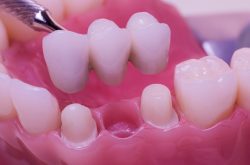Dental Bridge
-
Medically Reviewed by Greg Grillo, DDS | Last updated 10/18/2023
- Overview
Overview
What is a dental bridge?
Is a hole in your smile a cause for concern? Consider getting a dental bridge that fills gaps between your teeth to improve your smile and overall oral health. A dental bridge is a set of false teeth (known as a pontic) placed over abutment teeth on either side of the gap. Abutment teeth are your natural teeth which are filed down and covered with crowns attached to the pontic to give the dental bridge a seamless look. A dental bridge is most often a “fixed” restoration, meaning that it cannot be removed as easily as other dentures.

Dental Bridge Before & After Photo
Cost of dental bridge
The average cost of a dental bridge can range from $1,500 to $2,500 per tooth according to the American Dental Association (ADA). Here are some general estimates:
- Traditional dental bridge: A traditional dental bridge, which consists of a pontic (artificial tooth) held in place by dental crowns on adjacent teeth, can cost between $1,500 and $2,500 per tooth.
- Maryland bridge: A Maryland bridge, also known as a resin-bonded bridge, is a conservative option that uses metal or porcelain wings bonded to the backside of adjacent teeth. The cost for a Maryland bridge can range from $1,000 to $2,000 per tooth.
- Implant-supported bridge: An implant-supported bridge involves placing dental implants in the jawbone to support the bridge. This option provides superior stability and functionality but is generally more expensive. The cost for an implant-supported bridge can vary greatly, ranging from $5,000 to $10,000 or more.
Dental insurance may provide partial coverage for dental bridges, depending on your specific plan. Meet with a dentist who can evaluate your case and provide a detailed estimate based on your specific needs and circumstances.
Factors affecting the cost of treatment
There are several factors that can influence the cost of your procedure. Here are some of the top factors that influence cost.
- Your Dentist: The experience and reputation of your dentist can affect the cost of your procedure. Usually, dentists with extensive training or specialization may charge higher fees. When choosing a dentist, ensure they are certified by the American Board of Dental Specialties (ABDS) or the American Society of Cosmetic Dentistry (AACD). Although board-certification and memberships in any organization does not guarantee a successful outcome, dentists must meet stringent criteria in order to achieve membership and board-certification. You can be confident that you are working with a highly trained, and experienced dentist who will help ensure your dental bridge procedure goes smoothly.
- Location Matters: Where the dental practice is located can impact the cost. Dental services in urban areas or regions with a higher cost of living often come with a heftier price tag compared to rural areas. If you want to get a rough idea of the prices for dental procedures in your local area, you can use the Healthcare Blue Book, which functions similarly to Kelley Blue Book for estimating car prices.
- Type of Bridge: The type of bridge (Traditional bridges, Maryland bridges, and implant-supported) will affect the cost.
- Number of Missing Teeth: The number of missing teeth being replaced by the bridge will influence the cost. Bridges that replace more teeth will generally be more expensive compared to those replacing a single tooth. .
- Complexity of the Case: Cases that require significant work may require more advanced treatment techniques, appliances, and additional time.
- Additional Treatments: In some cases, a dental bridge may be part of a comprehensive treatment plan that includes other procedures that can increase the overall cost.
- Insurance: In certain cases, dental bridges may be covered by insurance if it’s deemed necessary for functional purposes.
If you are considering a dental bridge, schedule a consultation with an experienced cosmetic dentist near you. This will allow you to discuss your dental goals and gain a better understanding of the specific costs involved.
Is the cost covered by insurance?
Dental insurance coverage for a dental bridge isn’t one-size-fits-all; it varies based on your specific insurance plan and provider. Typically, this kind of coverage falls under the category of major dental care, and it comes with its own set of rules. Here are some key things to keep in mind regarding insurance coverage for a dental bridge:
- Pre-authorization and Waiting Periods: Many dental insurance plans ask for pre-authorization before they cover major dental care, like dental bridges. Additionally, there might be waiting periods before the coverage kicks in. You should delve into the details of your particular plan to understand these requirements.
- Coverage Limits: Dental insurance plans frequently impose a maximum coverage limit for major dental care, including bridges. This limit could be a fixed dollar amount or a percentage of the total treatment cost. Once you hit this coverage limit, any remaining expenses become your responsibility.
- Deductibles and Co-pays: Most dental insurance plans involve deductibles and co-pays that you, as the patient, need to cover out of your pocket. These are additional costs that factor into the overall expense.
- Alternate Benefit Clause: Some insurance plans have a rule called an “alternate benefit clause.” This means they’ll only pay for the least expensive treatment option. So, if you go for a fancier type of bridge that costs more, you might have to pay the extra amount yourself.
- In-network Providers: Dental insurance plans often have a group of preferred or in-network dentists. If you choose a dentist from this group, you might get better coverage or even discounts compared to dentists who aren’t in this network.
To get a better idea of what your dental insurance covers, carefully read your policy or get in touch directly with your insurance provider. They can give you all the specific details about your coverage and how it applies to your particular dental needs. Learn more about the basics of dental insurance from the National Association of Dental Plans (NADP).
Are you a candidate?
A missing tooth or teeth is more than just a cosmetic concern. It can result in bite irregularities (malocclusion), speech issues, TMJ disorder (a jaw joint condition), and increased risks for gum disease and dental decay. Dental bridges can help address these issues.
There are a variety of factors used to determine your candidacy for a dental bridge and the type of materials to best suit your needs. One important factor is having a healthy mouth that can support a bridge. Additional factors include, but are not limited to:
- The location of the missing tooth/teeth being replaced
- Your oral habits (such as grinding teeth)
- Your dental insurance plan
During the initial consultation, your dentist will take x-rays and an impression of the area where the tooth/teeth are missing. Your dentist will then discuss your options to determine the best course of treatment and help you approximate costs.
Types of dental bridges
There are four distinct types of fixed dental bridges:
- Traditional fixed dental bridge This is the most common type of bridge. It consists of a false tooth (or teeth) that are attached to dental caps or crowns placed over the abutment teeth. These are most often used with you have natural teeth on both sides of the gap. These bridges can be made of ceramics, porcelain-fused-to-metal, or metal.
- Cantilever dental bridge This bridge is similar to the traditional fixed bridge, but it uses only one crown to attach to one abutment tooth. It is mainly used for people who have teeth on only one side of the gap.
- Resin-bonded dental bridge Also known as the Maryland dental bridge, it is the most common type used to replace missing front teeth. Instead of using crowns attached to abutment teeth, the Maryland dental bridge uses a metal or porcelain framework that is attached to the backs of the abutment teeth.
- Implant-supported bridge This bridge is similar to the traditional fixed bridge, but it is held in place by implants surgically placed into the jawbone. These implants act like tooth roots to stably hold the bridge into place.
Implant-supported bridges are the strongest system. They typically require two separate procedures to be placed:
- The first surgery involves drilling a titanium implant into the jawbone.
- The second surgery places the bridge onto the implant.
Advantages and disadvantage
Advantages of dental bridges include:
- Improving your bite
- Preventing remaining teeth from shifting in your mouth
- Restoring your ability to chew and speak
- Natural aesthetics that look, feel, and function like natural teeth
- Do not require removal for cleaning
- Cost less than dental implants and other options
Disadvantages of dental bridges include:
- Requires modification of the teeth next to the bridge
- May need extra effort to clean under the bridge piece
- Bridge can fail if abutment teeth decay or if dental cement wears off
Dental bridge placement

On the first visit, your dentist will prepare the abutment teeth by filing them down, so the crown(s) can be placed over them to secure the dental bridge. They will then take an impression of your teeth and the gap to send to a laboratory where the bridge is fabricated. Your dentist will give you a temporary bridge to protect your exposed teeth while waiting for your permanent one. This process typically takes two to three weeks.
At the next visit, your dentist will fit the dental bridge on and secure it with a special cement. This means the bridge is fixed in your mouth and cannot be removed. It is important to let your dentist know if your bite alignment does not feel right or if you have any pain or discomfort. It will take a few days to get used to the feel of the bridge in your mouth.
How long will they last?
On average, dental bridges last at least five to seven years; if you are attentive to the bridge and your oral hygiene, they may last more than ten years. Be sure to brush your teeth twice a day and floss daily as well. You may need to use a special kind of floss called a threader that lets you slide the floss between your bridge and gum. This level of care helps prevent gum disease, which can affect your bridge and overall oral health.
Alternatives
Partial Dentures
One alternative to dental bridges is partial dentures. These are usually cheaper than dental bridges or implants and are easier to repair as well. Partial dentures are a removable piece of dental equipment that have artificial teeth on a pink plastic piece that matches the color of your gums. They are an effective alternative, but they may break easier, and are less stable than dental bridges or implants.
Dental Implants
Another alternative is dental implant surgery. These are threaded metal posts that are drilled into the jawbone to provide a stable anchor for the attachment of dental crowns. A fixed bridge can be attached to dental implants, or individual crowns can be attached as well. Implants require oral surgery and a longer recovery time. Additionally, they are one of the more expensive options, so they may not be right for everyone.
To learn more about dental bridges visit www.mouthhealthy.org.
EnhanceMyself.com relies on sources such as professional medical organizations, government agencies, academic institutions, and peer-reviewed scientific journals to write it’s articles. Learn more about how we ensure our content is accurate, in-depth, and unbiased by reading our editorial guidelines.
*Medical Disclaimer: This website does not provide medical advice. Read more.

